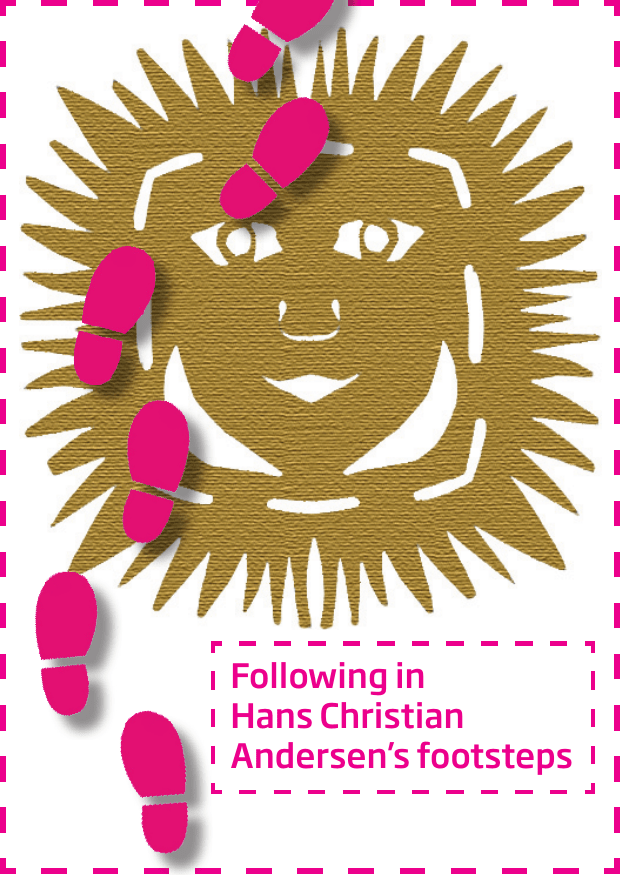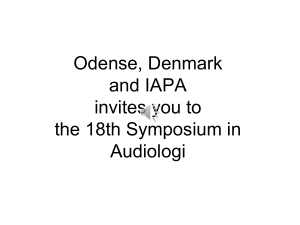Following in Hans Christian Andersen`s footsteps
advertisement

Following in Hans Christian Andersen’s footsteps In the Footsteps of H.C. Andersen Hans Christian Andersen’s home city has changed a great deal since he was a child. Even so, there still remain buildings and specific areas in the city, which look exactly as they did when the poet ran around in his childhood days. Round about the city centre you can find 13 granite squares, set in the pavement, marking places connected to Hans Christian Andersen. These squares are decorated with the Hans Christian Andersen paper cutting “The sun as a face”, which is also depicted on the front page of this brochure. 1 Hans Christian Andersen Museum In times past the attractive yellow house on the corner of Hans Jensens Stræde and Bangs Boder used to be part of the city’s slum area. The corner house, which looks so romantic today, comprises actually 3 dwellings, and was home for up to 5 families or about 20 people. Hans Christian Andersen’s grandmother and later his father’s aunt lived in the room – the flat – furthest down Bangs Boder. It is with all likelihood here that Hans Christian Andersen was born. Since 1908 the house has been dedicated to the memory of the poet, in the form of Hans Christian Andersen’s museum. Black Friars’ Square (Sortebrødre Torv) Odense Theatre, the only permanent theatre outside Copenhagen, used to be situated here. Hans Christian Andersen was spellbound by the theatre. The poverty-stricken boy helped the billsticker with his work and was rewarded with 2 theatre bills and programmes, fantasizing about these at home. Hans Christian Andersen made his début as a walk-on at Odense Theatre. His interest in the theatre and his dream of appearing on the stage drove Hans Christian Andersen to Copenhagen in 1819. The Workhouse The workhouse was situated on the corner of Overgade and Påskestræde, and a part of it can still be seen. Hans Christian Andersen used to go to school – sporadically and free of charge – on the first floor when he lived in Odense. On his way to school Hans Christian Andersen passed his father’s grave and the grammar school near the cathedral, where he dreamt of becoming a student. The fact was that the students’ future was promising there – they had good school books and got thorough education. 3 The Washing Site In the fairy-tale “She was no good” Hans Christian Andersen painted a sad picture of his childhood and his mother, who took comfort in the schnapps during her hard and cold work. Andersen’s mother died of the DT’s in 1833. 4 “No, she was good!” said the old servant, looking upward. I’ve known it for years, and more than ever since last night. I tell you, she was good – and God in his heaven knows it too, however much the world may say, ‘She was no good’.” This is how the poet ends his fairy-tale about the mother. She worked by the river, not at this washing site, but at one just like it a bit further up Odense River. Hans Christian Andersen Statue A large bronze statue of Hans Christian Andersen is situated near Odense Cathedral in the Garden, which is named after the poet. The statue was unveiled in the King’s Garden in 1888. The sculptor behind the statue was Louis Hasselriis (1844-1912). The first study was modelled in Rome in 1895, but the famous actress Johanne Luise Heiberg felt that the back of the statue seemed a little boring. Therefore, Hasselriis draped the poet’s overcoat across one shoulder, so that it broke the long surface of the back. The poet is commemorated each year on 2nd April by placing wreathes and by singing at the foot of the handsome statue. 5 6 Odense Prison Hans Christian Andersen’s grandmother was married to a convict from Odense Prison, and Hans Christian Andersen has been there too – however as a guest. His parents knew the warder, so Odense Prison, also known as “O.T.”, provided the setting for the celebrations at a family re-union. However, Hans Christian Andersen was too scared to participate, because he was frightened of the convicts acting as waiters at the party. In the novel: “O.T.” Hans Christian Andersen describes this awful institution. The Bishop’s Manor Two days before the cobbler’s son Andersen left Odense in the hope of making a career for himself at the Royal Theatre in Copenhagen, he paid a visit to Bishop Plum, who lived at a vicarage – a little closer to Odense River than 7 this. Andersen wanted to perform in order to earn money for his travels. The bishop’s wife invited the boy to come again that evening. The chandelier in the living room was lit, and the family and their guests gathered around Hans Christian Andersen. The cobbler’s son entertained the guests for two hours with extracts from comedies and tragedies, with songs and with poetry recitals. One of the bishop’s young guests wrote in his diary: “This was a very pleasant surprise for me”. The Childhood Home Hans Christian Andersen’s memories stem particularly from the childhood home at Munkemøllestræde 3, where he lived from the age of two until he was fourteen (1807-1819). The fairytale: “The Snow Queen” was inspired from here. The oldest and first commemorative plaque for Hans Christian Andersen can be seen on the house façade. It was unveiled on the poet’s 70th birthday in 1875. Today the house accommodates a small exhibition over Hans Christian Andersen’s childhood. 8 9 Saint Canute’s Church Odense cathedral, Saint Canute’s Church, provided the setting for three events in Hans Christian Andersen’s life. It was here that his parents got married on 2nd February 1805, his father was buried at the age of 33 on 30th April 1816, and the cobbler’s son was confirmed on 18th April 1819. At his confirmation Hans Christian Andersen wore his father’s old jacket, and a pair of leather boots had been bought for the occasion. In sheer joy and pride over the new boots he completely forgot to concentrate on the solemnity of the ceremony. Odense Town Hall The town hall looked rather different in Hans Christian Andersen’s day – it was much smaller and more humble. Hans Christian Andersen’s grandmother had been on bread and water in the cellar under the town hall because she had given birth to three children out of wedlock. But Hans Christian Andersen experienced the best day of his life from the window on the town hall’s first floor – on 6th December 1867 he received the people’s ovation and became an honorary citizen of Odense. Flakhaven was lit up by the people’s torchlight procession that day. Odense was illuminated in honour of the poet – what had been prophesied of him as a child came true. 10 11 The Franciscan Hospital (Gråbrødre) In Hans Christian Andersen’s day Gråbrødre was a whole complex with church, hospital and madhouse – a lunatic asylum. The church is now gone, torn down after Napoleon’s Spanish auxiliary troops left it in a state of devastation. But some of the old buildings still remain. It was here that Hans Christian Andersen’s grandmother tended the garden, here his grandfather was admitted to the hospital in 1823 as madman, and ten years later Hans Christian Andersen’s mother died here, deeply alcoholic, on the floor under the roof in the almshouse, the so-called “Doctors’ Boder”. It was also here that Hans Christian Andersen heard stories from the old poor people, and it was here it made him shudder to think of the hospitalized mentally retarded and insane people. Odense Castle Odense became “little Copenhagen” when the castle became the residence of Prince Christian Frederik (later King Christian VIII) in 1815, where he was appointed Governor of the Funen Diocese. Hans Christian Andersen’s mother sometimes worked here as washerwoman, and in order that Hans Christian shouldn’t be left at home alone, she often took him with her to work. Thus, Hans Christian frequently played in the courtyard with the other servants’ children – and also with Prince Frits (later Frederik VII). Odense only has two honorary citizens. Funnily enough these are the King and the poet, Frederik VII and Hans Christian Andersen – one from upper-class society and the other a more humble member of the community. 12 St Hans Church Hans Christian Andersen was christened in the interesting old church on Easter Monday in 1805. This was ten days after his birth; he was weak when born and was therefore baptized at home. During the christening ceremony the priest worked himself up because the new-born child screamed so much. One of the godparents comforted the mother by saying that the louder the child screamed, the better a singer he would become. He was going to prove more right than he realized. Two months prior to the christening, the church’s old priest had died. His widow later became Hans Christian Andersen’s opposite neighbour in Munkemøllestræde. It was at her house that the cobbler’s son decided to become a poet. 13 Odense Bys Museer © City Map 13 1 12 Asylgad e se Vindegade H s an Je gade ngs Bo der Ove e Fisk Jernbane gad e 2 Ba rre gad S n- Nø Slots ns tr. ade Asylg pro gø de 4 10 es Pl. Al 9 Klar ega ng en be rg ba 5 de 8 nsg inse npr 6 Kro Klaregade ade 7 Filosofgangen Nedergade ade eS rga este Kli de veg vet Ov V 3 Tor etor 11 rga www.visitodense.com ni ga de





